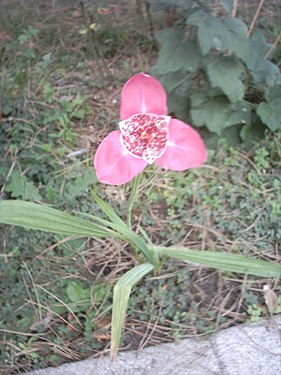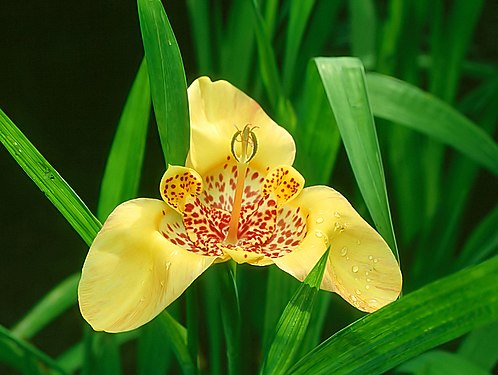Difference between revisions of "Tigridia pavonia"
| (2 intermediate revisions by one other user not shown) | |||
| Line 1: | Line 1: | ||
| − | + | {{SPlantbox | |
| − | | | + | |familia=Iridaceae |
| − | | | + | |genus=Tigridia |
| − | | | + | |species=pavonia |
| − | | | + | |habit=bulbous |
| − | | | + | |Min ht box=24 |
| − | | | + | |Min ht metric=in |
| − | | | + | |Max ht box=48 |
| − | | | + | |Max ht metric=in |
| − | | | + | |height_ref=Flora - A Gardener's Encyclopedia |
| − | | | + | |Min wd box=12 |
| − | | | + | |Min wd metric=in |
| − | | | + | |Max wd box=20 |
| − | | | + | |Max wd metric=in |
| − | | | + | |width_ref=Flora - A Gardener's Encyclopedia |
| − | | | + | |lifespan=perennial |
| − | | | + | |life_ref=Flora - A Gardener's Encyclopedia |
| − | | | + | |exposure=sun |
| − | | | + | |sun_ref=Flora - A Gardener's Encyclopedia |
| − | | | + | |features=flowers |
| − | | | + | |flower_season=early spring, mid spring, late spring, early summer, mid summer, late summer |
| − | | | + | |flower_ref=Flora - A Gardener's Encyclopedia |
| − | | | + | |flowers=red, orange, yellow, pink |
| − | | | + | |Temp Metric=°F |
| − | | | + | |min_zone=9 |
| − | | | + | |usda_ref=Flora - A Gardener's Encyclopedia |
| − | | | + | |max_zone=10 |
| − | | | + | |image=Tigrida pavonia.JPG |
| − | + | |image_width=240 | |
}} | }} | ||
| + | '''''Tigridia pavonia''''' is the best-known species from the genus ''[[Tigridia]]''. It is included in the [[Iridaceae]] family. This famous ornamental [[plant]] comes from [[Mexico]]. It's very popular among the lovers of interesting flowers. The blooms open early in the morning and are already closed around 5 P.M. when dusk begins to fall. Every day a different bloom is opened. The [[plants]] that are grown from seeds bloom in the first year after they are sowed. | ||
| + | |||
| + | The flower has a big variety of colors. There are many sorts of this species that are grown for their ornamental traits. | ||
| + | |||
{{Inc| | {{Inc| | ||
| − | Tigridia pavonia, Ker-Gawl. Tiger-Flower. Shell-Flower. Erect, usually unbranched, 1 1/2 – 2 1/2 ft. tall, glabrous, with several sword-shaped, strongly plicate long-pointed lvs., the spathe- lvs. 3-5 in. long: fls. produced in succession through the warm season, very large and showy, in some forms 5-6 in. across, oddly marked, with a cup-shaped or saucer-shaped center and wide-spreading limb formed by the obovate outer segms. which are bright red on the limb, and purple, yellow, or red-spotted on the claw; inner segms. panduriform (fiddle-shaped), about half the length of the outer ones, the blade ovate-acute, orange-yellow, and copiously spotted. Mex. and Guatemala. | + | Tigridia pavonia, Ker-Gawl. Tiger-Flower. Shell-Flower. Erect, usually unbranched, 1 1/2 – 2 1/2 ft. tall, glabrous, with several sword-shaped, strongly plicate long-pointed lvs., the spathe- lvs. 3-5 in. long: fls. produced in succession through the warm season, very large and showy, in some forms 5-6 in. across, oddly marked, with a cup-shaped or saucer-shaped center and wide-spreading limb formed by the obovate outer segms. which are bright red on the limb, and purple, yellow, or red-spotted on the claw; inner segms. panduriform (fiddle-shaped), about half the length of the outer ones, the blade ovate-acute, orange-yellow, and copiously spotted. Mex. and Guatemala. |
| + | |||
| + | Var. conchiflora, Hort. (T. conchiflora, Sweet), has bright yellow fls. | ||
| + | Var. Watkinsonii, Hort. (var. aurea, Hort. T. conchiflora Watkinsonii, Paxt.). Raised from seeds of var. conchiflora pollinized by T. Pavonia, before 1840, by J. Horsefield, Manchester, England. Horsefield is quoted as follows by Paxton: "In habit and strength this hybrid resembles T. Pavonia, the male parent; but in color and the markings of the flower it resembles T. conchiflora, the female parent; the large outer sepals, however, are of a very deep yellow, inclining to orange, and sometimes elegantly streaked with red lines; whilst the spotted center equals, if not surpasses, the brilliancy of either of the species. One of its greatest merits is being so free a bloomer, and as easy to cultivate and increase as T. Pavonia, whereas T. conchiflora is rather delicate, increases slowly, and is easily lost." Dutch bulb-dealers may still offer it. | ||
| + | Var. alba, Hort., has white fls., with red spots in the throat. | ||
| + | Var. alba immaculata, Hort., is a spotless white variety, a sport from var. alba. | ||
| + | Var. flava, Hort., has pale yellow fls. with red-spotted center. | ||
| + | Var. canariensis, Hort., is also a pale yellow-fld. form, but named as if an inhabitant of the Canaries. | ||
| + | Var. lutea immaculata, Hort., has pure yellow spotless fls. | ||
| + | Var. rosea, Hort., has rose-colored fls. with yellow variegated center. | ||
| + | Var. lilacea, Hort., has lilac fls. with spotted center. Gn. 45:26. Var. speciosa, Hort., is a partially dwarf form with deeper red color, the interior of the cup being similar in color to the limb. | ||
| + | Var. grandiflora, Hort., has fls. much like those of T. Pavonia itself except that they are larger and brighter colored. Identical with this, or subtypes of it, are the forms known as Wheeleri, coccinea, splendens. Most of the marked departures in colors of T. Pavonia are recent. In catalogues the above names often appear as if they were species names. | ||
{{SCH}} | {{SCH}} | ||
}} | }} | ||
| Line 47: | Line 62: | ||
==Gallery== | ==Gallery== | ||
| − | + | <gallery perrow=5> | |
| − | + | File:Palenque.jpg | |
| − | + | File:Tigrida pavonia.JPG | |
| − | + | File:Tigrida pavonia.jpg | |
| − | + | File:Tigrida-pavonia-flower.jpg | |
| − | + | File:Tigridia pavonia Duerkheim.jpg | |
| + | File:Tigridia pavonia.jpg | ||
| + | File:Tigridia-pavonia-habitus.jpg | ||
| + | File:Unbekannte Blume-2.JPG | ||
</gallery> | </gallery> | ||
| Line 64: | Line 82: | ||
*{{wplink}} | *{{wplink}} | ||
| − | + | __NOTOC__ | |
| − | |||
| − | |||
| − | |||
Latest revision as of 19:35, 27 April 2010
| Habit | bulbous
| |
|---|---|---|
| Height: | ⇕ | 24 in"in" can not be assigned to a declared number type with value 24. to 48 in"in" can not be assigned to a declared number type with value 48. |
| Width: | ⇔ | 12 in"in" can not be assigned to a declared number type with value 12. to 20 in"in" can not be assigned to a declared number type with value 20. |
| Lifespan: | ⌛ | perennial |
| Bloom: | ❀ | early spring, mid spring, late spring, early summer, mid summer, late summer |
| Exposure: | ☼ | sun |
|---|---|---|
| Features: | ✓ | flowers |
| USDA Zones: | 9 to 10 | |
| Flower features: | ❀ | red, orange, yellow, pink |
|
Tigridia > |
pavonia > |
Tigridia pavonia is the best-known species from the genus Tigridia. It is included in the Iridaceae family. This famous ornamental plant comes from Mexico. It's very popular among the lovers of interesting flowers. The blooms open early in the morning and are already closed around 5 P.M. when dusk begins to fall. Every day a different bloom is opened. The plants that are grown from seeds bloom in the first year after they are sowed.
The flower has a big variety of colors. There are many sorts of this species that are grown for their ornamental traits.
Read about Tigridia pavonia in the Standard Cyclopedia of Horticulture
|
|---|
|
Tigridia pavonia, Ker-Gawl. Tiger-Flower. Shell-Flower. Erect, usually unbranched, 1 1/2 – 2 1/2 ft. tall, glabrous, with several sword-shaped, strongly plicate long-pointed lvs., the spathe- lvs. 3-5 in. long: fls. produced in succession through the warm season, very large and showy, in some forms 5-6 in. across, oddly marked, with a cup-shaped or saucer-shaped center and wide-spreading limb formed by the obovate outer segms. which are bright red on the limb, and purple, yellow, or red-spotted on the claw; inner segms. panduriform (fiddle-shaped), about half the length of the outer ones, the blade ovate-acute, orange-yellow, and copiously spotted. Mex. and Guatemala. Var. conchiflora, Hort. (T. conchiflora, Sweet), has bright yellow fls. Var. Watkinsonii, Hort. (var. aurea, Hort. T. conchiflora Watkinsonii, Paxt.). Raised from seeds of var. conchiflora pollinized by T. Pavonia, before 1840, by J. Horsefield, Manchester, England. Horsefield is quoted as follows by Paxton: "In habit and strength this hybrid resembles T. Pavonia, the male parent; but in color and the markings of the flower it resembles T. conchiflora, the female parent; the large outer sepals, however, are of a very deep yellow, inclining to orange, and sometimes elegantly streaked with red lines; whilst the spotted center equals, if not surpasses, the brilliancy of either of the species. One of its greatest merits is being so free a bloomer, and as easy to cultivate and increase as T. Pavonia, whereas T. conchiflora is rather delicate, increases slowly, and is easily lost." Dutch bulb-dealers may still offer it. Var. alba, Hort., has white fls., with red spots in the throat. Var. alba immaculata, Hort., is a spotless white variety, a sport from var. alba. Var. flava, Hort., has pale yellow fls. with red-spotted center. Var. canariensis, Hort., is also a pale yellow-fld. form, but named as if an inhabitant of the Canaries. Var. lutea immaculata, Hort., has pure yellow spotless fls. Var. rosea, Hort., has rose-colored fls. with yellow variegated center. Var. lilacea, Hort., has lilac fls. with spotted center. Gn. 45:26. Var. speciosa, Hort., is a partially dwarf form with deeper red color, the interior of the cup being similar in color to the limb. Var. grandiflora, Hort., has fls. much like those of T. Pavonia itself except that they are larger and brighter colored. Identical with this, or subtypes of it, are the forms known as Wheeleri, coccinea, splendens. Most of the marked departures in colors of T. Pavonia are recent. In catalogues the above names often appear as if they were species names. CH
|
Cultivation
- Do you have cultivation info on this plant? Edit this section!
Propagation
- Do you have propagation info on this plant? Edit this section!
Pests and diseases
- Do you have pest and disease info on this plant? Edit this section!
Species
Gallery
References
- Standard Cyclopedia of Horticulture, by L. H. Bailey, MacMillan Co., 1963
External links
- w:Tigridia pavonia. Some of the material on this page may be from Wikipedia, under the Creative Commons license.
- Tigridia pavonia QR Code (Size 50, 100, 200, 500)








